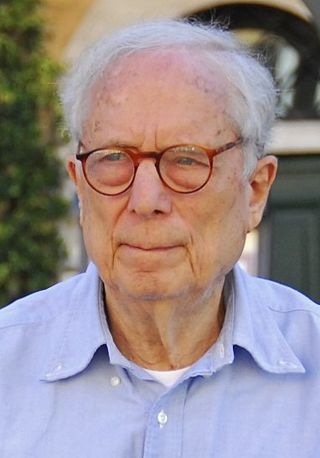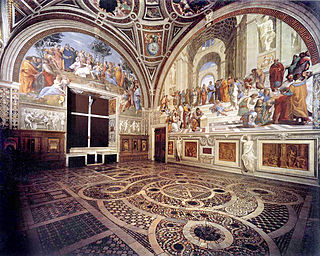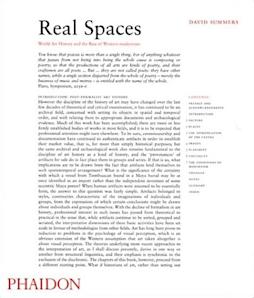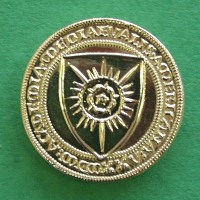Related Research Articles

Modernism is a philosophical, religious, and art movement that arose from broad transformations in Western society during the late 19th and early 20th centuries. The movement reflected a desire for the creation of new forms of art, philosophy, and social organization which reflected the newly emerging industrial world, including features such as urbanization, architecture, new technologies, and war. Artists attempted to depart from traditional forms of art, which they considered outdated or obsolete. The poet Ezra Pound's 1934 injunction to "Make it New" was the touchstone of the movement's approach.

Michelangelo di Lodovico Buonarroti Simoni, known mononymously as Michelangelo, was an Italian sculptor, painter, architect, and poet of the High Renaissance. Born in the Republic of Florence, his work was inspired by models from classical antiquity and had a lasting influence on Western art. Michelangelo's creative abilities and mastery in a range of artistic arenas define him as an archetypal Renaissance man, along with his rival and elder contemporary, Leonardo da Vinci. Given the sheer volume of surviving correspondence, sketches, and reminiscences, Michelangelo is one of the best-documented artists of the 16th century. He was lauded by contemporary biographers as the most accomplished artist of his era.

David is a masterpiece of Italian Renaissance sculpture, created from 1501 to 1504 by Michelangelo. With a height of 5.17 metres, the David was the first colossal marble statue made in the early modern period following classical antiquity, a precedent for the 16th century and beyond. David was originally commissioned as one of a series of statues of twelve prophets to be positioned along the roofline of the east end of Florence Cathedral, but was instead placed in the public square in front of the Palazzo della Signoria, the seat of civic government in Florence, where it was unveiled on 8 September 1504. In 1873, the statue was moved to the Galleria dell'Accademia, Florence, and in 1910 replaced at the original location by a replica.

Robert Charles Venturi Jr. was an American architect, founding principal of the firm Venturi, Scott Brown and Associates.

In art history, the High Renaissance was a short period of the most exceptional artistic production in the Italian states, particularly Rome, capital of the Papal States, and in Florence, during the Italian Renaissance. Most art historians state that the High Renaissance started between 1490 and 1500, and ended in 1520 with the death of Raphael, although some say the High Renaissance ended about 1525, or in 1527 with the Sack of Rome by the mutinous army of Charles V, Holy Roman Emperor, or about 1530. The best-known exponents of painting, sculpture and architecture of the High Renaissance include Leonardo da Vinci, Michelangelo, Raphael, and Bramante. In the 21st century, the use of the term has been frequently criticized by some academic art historians for oversimplifying artistic developments, ignoring historical context, and focusing only on a few iconic works.

Erwin Panofsky was a German-Jewish art historian, whose academic career was pursued mostly in the U.S. after the rise of the Nazi regime.

Postmodern architecture is a style or movement which emerged in the late 1950s as a reaction against the austerity, formality, and lack of variety of modern architecture, particularly in the international style advocated by Philip Johnson and Henry-Russell Hitchcock. The movement was introduced by the architect and urban planner Denise Scott Brown and architectural theorist Robert Venturi in their 1972 book Learning from Las Vegas. The style flourished from the 1980s through the 1990s, particularly in the work of Scott Brown & Venturi, Philip Johnson, Charles Moore and Michael Graves. In the late 1990s, it divided into a multitude of new tendencies, including high-tech architecture, neo-futurism, new classical architecture, and deconstructivism. However, some buildings built after this period are still considered postmodern.

Sir Ernst Hans Josef Gombrich was an Austrian-born art historian who, after settling in England in 1936, became a naturalised British citizen in 1947 and spent most of his working life in the United Kingdom.
Richard John Alexander Talbert is a British-American contemporary ancient historian and classicist on the faculty of the University of North Carolina at Chapel Hill, where he was William Rand Kenan, Jr., Professor of History and is currently Research Professor in charge of the Ancient World Mapping Center. Talbert is a leading scholar of ancient geography and ideas of space in the ancient Mediterranean world.
James L. Axtell was an American historian. He was a professor of history at the College of William and Mary in Williamsburg, Virginia. Axtell, whose interests lie in American Indian history and the history of higher education, was the William R. Kenan, Jr. Professor of Humanities. He was elected a Fellow of the American Academy of Arts and Sciences in 2004. Axtell retired at the end of the spring 2008 semester, although he taught a class at Princeton University in the fall of 2009.
The Alice Davis Hitchcock Book Award, established in 1949, by the Society of Architectural Historians, annually recognizes "the most distinguished work of scholarship in the history of architecture published by a North American scholar." The oldest of the six different publication awards given annually by the Society, it is named after the mother of architectural historian Henry-Russell Hitchcock.
Frederick Hartt (1914–1991) was an Italian Renaissance scholar, author and professor of art history. His books include History of Italian Renaissance Art, Art: A History of Painting, Sculpture, and Architecture (two volumes), Michelangelo , The Sistine Chapel and The Renaissance in Italy and Spain . He was also involved with cataloging and repatriating art work looted and stolen by the Third Reich during World War II.

David John Watkin, FRIBA FSA was a British architectural historian. He was an emeritus fellow of Peterhouse, Cambridge, and professor emeritus of History of Architecture in the Department of History of Art at the University of Cambridge. He also taught at the Prince of Wales's Institute of Architecture.
Leopold David Ettlinger was a Warburg Institute historian of the Italian renaissance and UC Berkeley Art Department Chair, from 1970 to 1980. He wrote some of his books together with his third wife Helen Shahrokh Ettlinger.
William J. R. Curtis is an architectural historian whose writings have focused on twentieth century architecture. Curtis seems particularly interested in broadening the "canon" to include a wider range of architects working across the world.
Theodore K. Rabb was an American historian specializing in the early modern period of European history. He was a Professor Emeritus in the Department of History at Princeton University. He was one of the leading scholars in the field of 16th- and 17th-century Europe, focusing on varying topics such as climate history and food history.
Paul Evdoros Alexander Joannides is an emeritus professor of the History of Art in the University of Cambridge and fellow of Clare Hall.

Real Spaces: World Art History and the Rise of Western Modernism is a non-fiction book by art historian David Summers, who aims to reconcile Western art history to artistic cultural production around the world from all time periods.
John Kinder Gowran Shearman was an English art historian who also taught in America. He was a specialist in Italian Renaissance painting, described by his colleague James S. Ackerman as "the leading scholar of Italian Renaissance painting", who published several influential works, but whose expected major book on Quattrocento painting, for the Penguin/Yale History of Art series, never appeared. However, what is widely acknowledged as his most influential book, on the concept of Mannerism, published in 1967, is still in print.

The Haskins Medal is an annual medal awarded by the Medieval Academy of America. It is awarded for the production of a distinguished book in the field of medieval studies.